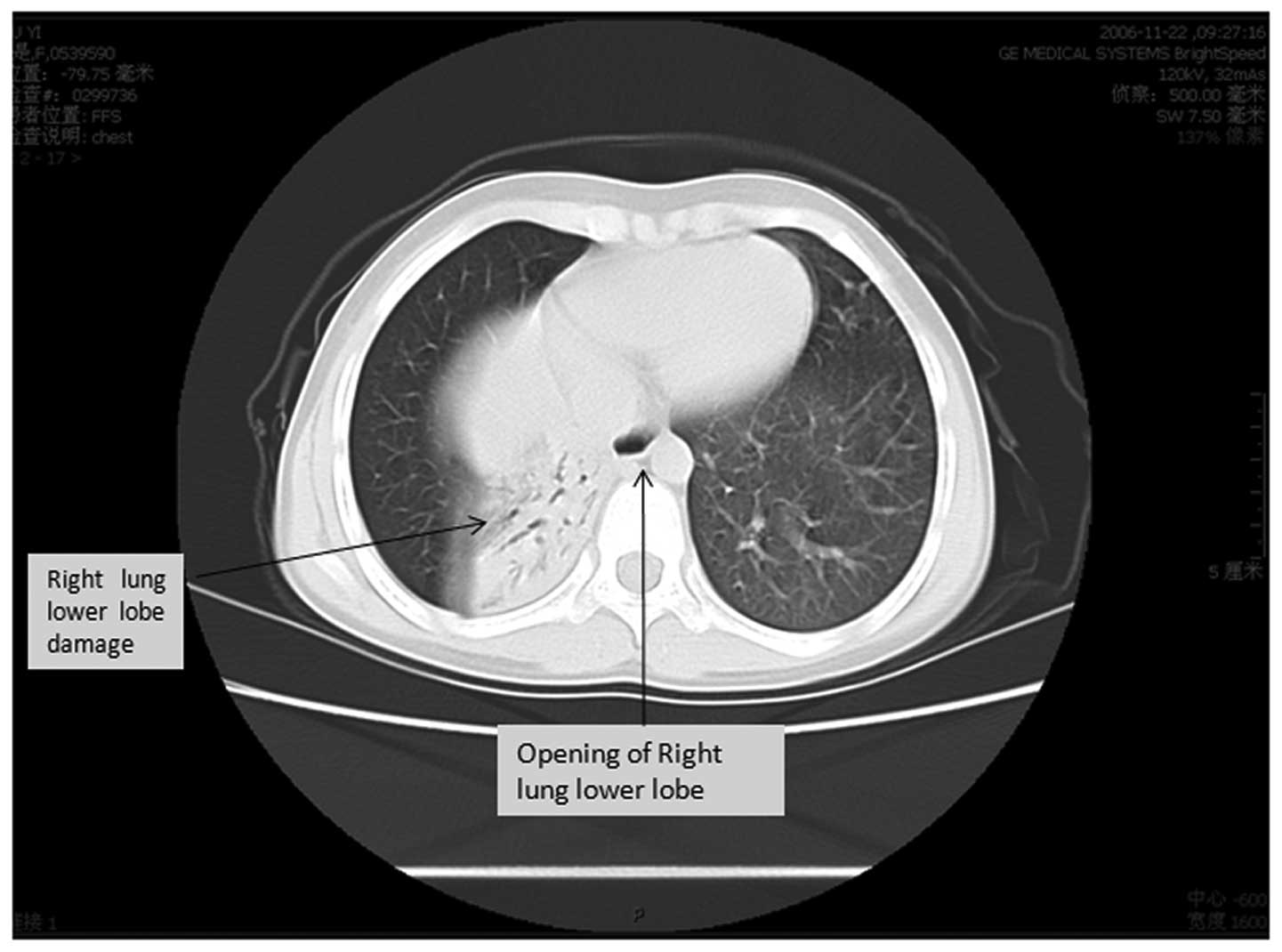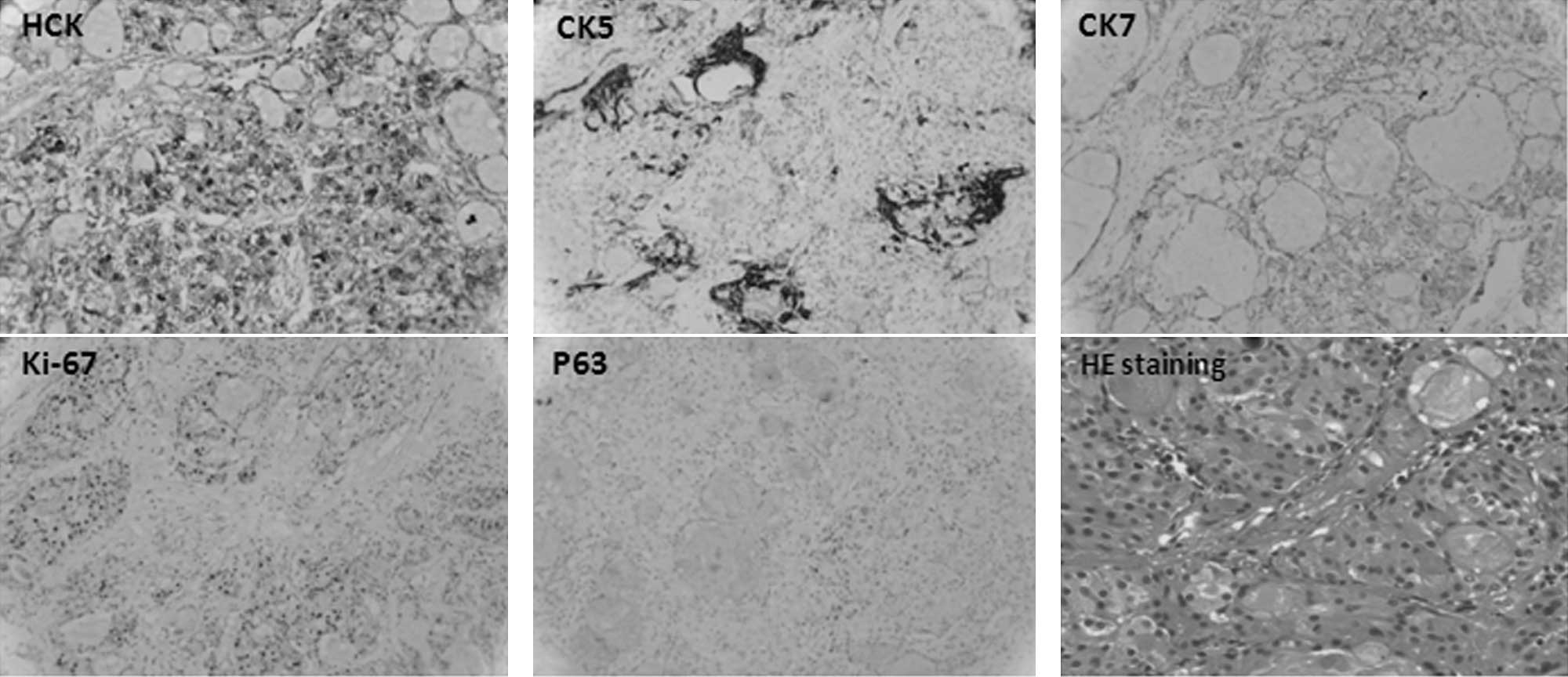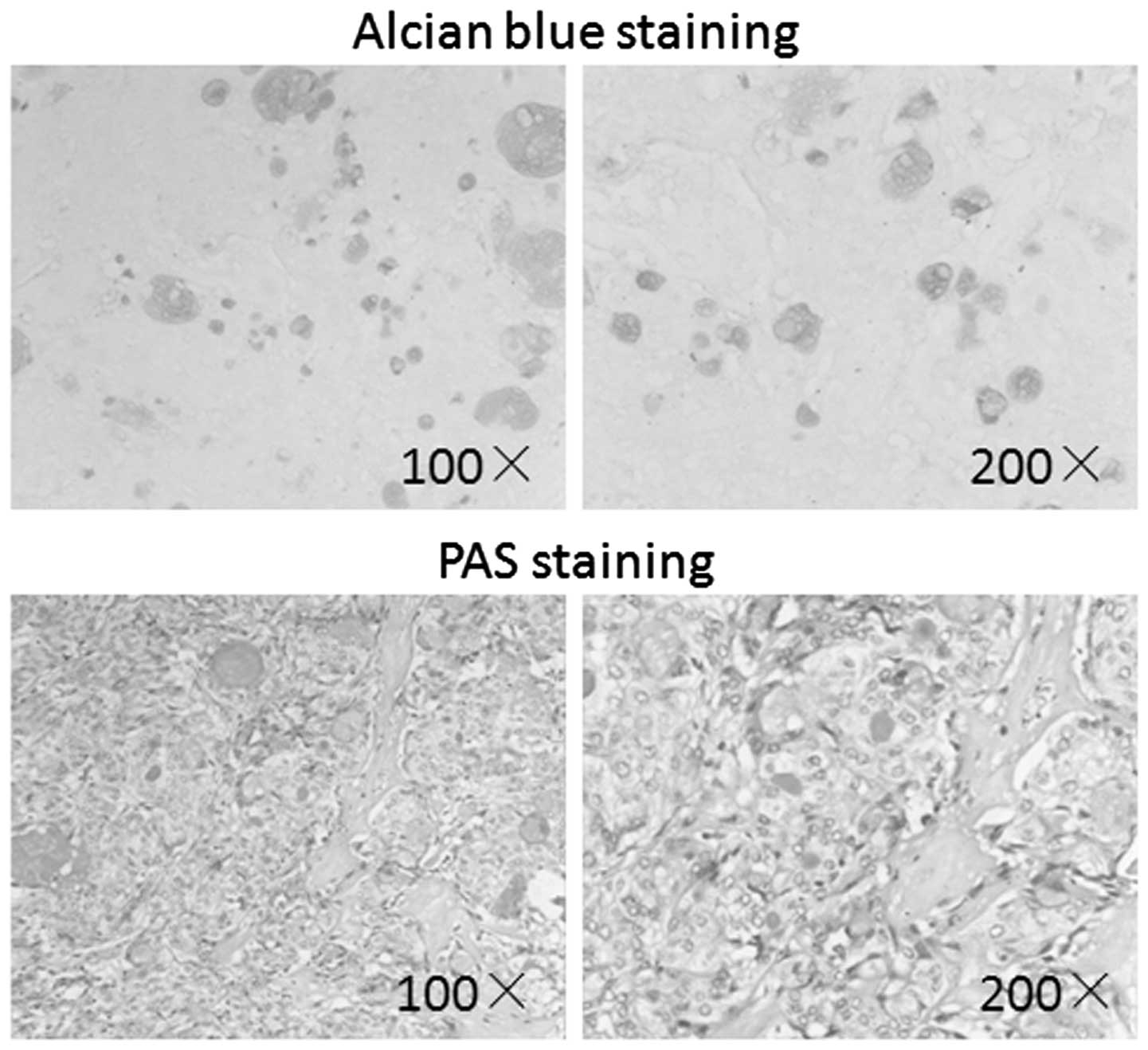Introduction
Mucoepidermoid carcinoma (MEC) is the most common
type of salivary gland malignancy in adults. It is also found in
other areas, including bronchi, lacrimal sac and thyroid. MEC is
not common in the lungs, particularly in children, accounting for
only 0.1–0.2% of primary lung cancers. Generally, pulmonary MEC
presents as a painless, slow-growing mass that is firm or hard,
which may block bronchial tubes and cause obstructive pneumonia.
Although the tumor is not encapsulated, the tumor usually has a low
malignant potential (1–3). MEC is characterized by squamous cells,
mucus-secreting cells and intermediate cells, and is histologically
diagnosed by Alcian blue and periodic acid-Schiff staining. The
present study describes the case of a seven-year-old female with
MEC. Following the appropriate treatment, the patient appeared
normal during the six-year follow-up period. Written informed
consent was obtained from the patient.
Case report
A seven-year-old female presented with a one-year
history of recurrent hemoptysis with no evident cause. A sudden
onset of hemoptysis had compelled the patient to seek treatment at
the Renji Hospital (Shanghai, China). An initial diagnosis
indicated that the patient was apyrexial, experiencing
bronchiectasis and producing diminished breath sounds in the right
inferior zone. Upon further examination, a computed tomography (CT)
scan revealed atelectasis of the right lower lobe associated with
local partial pulmonary tissue collapse and a consolidation of the
right middle and lower lobes (Fig.
1). The remainder of the bronchial tree appeared normal. One
year prior to admittance to the Renji Hospital, the patient was
admitted to the emergency department of a local grade three and
first-class hospital due to coughing and hemoptysis. The emergency
doctors prescribed antibiotics and hemostatics, which partially
relieved the symptoms. However, the disease recurred six months
later and the patient was administered the same treatment, which
provided some relief. One year after the first hospitalization, the
hemoptysis volume had doubled and the patient was transferred to
the Renji Hospital. A bronchoscopy was performed at a hospital in
Hangzhou (Zhejiang, China). However, the bronchoscopy may have
caused airway bleeding, resulting in an obscured visual field and
immediate termination of the procedure. In addition, the patient
had no significant individual or family history of pulmonary
disease. However, the patient’s grandmother had succumbed due to
colorectal carcinoma a few years prior to this incidence.
Based on the previous diagnosis and information, the
patient underwent surgery in the Renji Hospital. During surgery,
congestion-like changes to the bronchial tissues were discovered in
the lower lobe of the right lung, and several bleeding sites were
identified in the airway. A granulomatous mass was located at the
site of the middle lobar bronchial opening. In addition, a right
lower and middle lobectomy was performed, followed by lymph node
dissection.
The histology of the endobronchial specimen revealed
a grade II MEC with clean resection margins. The carcinoma was
2.5×1.5×1.5 cm3 in size. Although histopathology
revealed that the majority of the carcinoma was localized within
the epidermis of the bronchus, certain sections had invaded the
bronchial wall. An immunohistochemical examination revealed that
the carcinoma cells were positive for high-molecular weight
cytokeratin (HCK), also known as 34βE12 (+++), CK5 (++), CK7 (+++),
Ki67 (+) and p63 (+; Fig. 2) and
negative for p27, TTF-1, EGFR, p53, CD10 and p63 (data not shown),
where + is trace/negative, ++ is weakly positive and +++ is
strongly positive. Alcian blue (AB) and periodic acid-Schiff (PAS)
staining were used to detect the presence and distribution of the
acidic and neutral carbohydrates, respectively. AB and PAS staining
was positive in the MEC specimen (Fig.
3). Based on the evidence, the patient was diagnosed with stage
Ib (T2aN0M0) non-small cell lung cancer, according to the staging
guidelines (4). A pathological
analysis also indicated that the MEC in this patient did not differ
from that observed in adult patients.
Following the surgery, the seven-year-old patient
made an uneventful post-operative recovery, and the follow-up
examination six years later did not reveal any clinical or
radiological evidence of disease recurrence.
Discussion
MEC is a malignant glandular epithelial neoplasm
with typical characteristics, including mucous and epidermoid cells
and oncotic features (5). MEC
commonly occurs in the salivary glands, but is also observed in
other organs, including the breast, pancreas, thyroid gland,
trachea and bronchus (6). MEC of
the trachea and bronchi is rare, accounting for 0.1–0.5% of all
lung carcinomas (7,8). MEC is one of the most common childhood
primary malignant tumors, representing ~10% of malignant lung
tumors in children (9). Although
the age range of patients with MEC in the lung is extensive, young
patients, particularly children, are not commonly observed
(7). Rapidis et al(10) reported an age range of 29–86 years
in a cohort of 18 patients, while Ozawa et al(11) reported age ranges of 22–86 years and
33–70 years in cohorts of 43 patients and 30 patients, respectively
(5). Cases involving patients of
<10 years old are rare. Due to the rarity of this pulmonary
carcinoma in children, MEC is usually not the first consideration
when a child presents with recurrent atelectasis or respiratory
tract infection. As a result, the diagnosis may be delayed
(9). Symptoms are often present for
up to 20 months prior to this delayed diagnosis (mean, 11 months)
(12). In the present case, the
diagnosis was delayed by one year.
The common symptoms and signs of MEC of the bronchus
are coughing, hemoptysis, bronchitis, wheezing, fever, chest pain
and clubbing of the fingers (13).
Children with bronchial tumors are more likely to present symptoms
that are more specific than their adult counterparts. Tsuchiya
et al(14) and Dinopoulos
et al(13) summarized the
symptoms of MEC in child patients and concluded that coughing,
hemoptysis, fever and recurrent pneumonia were the most common
signs. Clubbing, wheezing and recurrent colds have also been
observed (14). Bronchial MEC
usually occurs in the main or lobar bronchi as a soft, vascular
polypoid mass that induces bronchial obstruction, recurrent
pneumonias, coughing and/or hemoptysis (15). With growth, the tumor initially
partially and eventually completely, obstructs the bronchus, thus
interfering with distal ventilation. The patient develops dyspnoea,
wheezing and cough. Further obstruction results in pneumonia and
atelectasis, which if unresolved, may result in bronchiectasis
(16). In the present study, the
initial clinical signs were a one-year history of recurrent
hemoptysis and coughing. Antibiotics and hemostatics relieved the
symptoms of the disease, which was also confusing. If recurrent
hemoptysis, coughing and pneumonia or pneumonia-like symptoms occur
in child patients, MEC should be considered during the diagnosis.
Tests, including a radiographical diagnosis, plain radiography,
bronchography and CT should be performed to confirm the diagnosis
(17).
Since CT is the most sensitive technique for
detecting and characterizing parenchymal disease, it has become the
procedure of choice for further investigation. CT may be useful in
assessing the extent of the disease. Familiarity with the
appearance of these lesions on CT may assure an accurate diagnosis
and optimize the management of the condition of the patient
(18). In the present study, only
CT was performed, which revealed right lower lobe atelectasis
associated with local partial pulmonary tissue collapse and a
consolidation of the right middle and lower lobes (Fig. 1). Although CT detected MEC in the
present study, the radiographic differential diagnosis is not
useful in evaluating MEC with small lesions (19). Several direct approaches, including
fiberoptic bronchoscopy and 18F-fluorodeoxyglucose
positron emission tomography (FDG-PET)/CT imaging (20–22),
may avoid the problems that are associated with radiographical
techniques. However, in the present case, the young patient
experienced hemoptysis accompanied by airway bleeding, and a
bronchoscopy may have caused massive hemorrhage. Therefore,
bronchoscopy should be used more carefully or stopped when severe
airway bleeding occurs. These shortcomings highlight the urgent
requirement for a new method for the diagnosis of pediatric MEC
that does not cause airway bleeding.
Generally, when an endobronchial mass is present in
a child, the clinical consideration typically includes the
aspiration of exogenous objects, respiratory tract papillomatosis,
an inflammatory pseudotumor and, rarely, a metastatic or primary
tumor. Whether the mass is benign or malignant may be determined
based on the clinical signs or symptoms alone. The total removal of
the lesion, with the sacrifice of as little normal lung tissue as
possible, is required. When technically possible, a sleeve
resection of the involved bronchus is recommended. However, in the
majority of cases, the location of the lesions requires a lobectomy
for complete removal (23,24). In the present study, an appropriate
surgical procedure was performed. It is well known that planning a
precise follow-up procedure depends on the disease characteristics,
including the pathological type or the accurate location of the
lesion. Therefore, in the present study, a right lower and right
middle lobectomy was performed. Following this, a lymph node
dissection was performed.
The pathological diagnosis is indispensable
(25). Histological analysis is the
last and the most significant method for staging MEC. Histological
staining is useful for determining the properties and grades of
specimens (1,25). Bronchial MEC usually forms
neoplastic excretory duct reserve cells, which are histologically
similar to MEC of the salivary glands (13,26).
Several cytokeratins, including AE1, CK7, CK5/6, CK7 and CK8, as
well as PCNA, Ki-67, p63, p53, CD10 and p27, are common markers
that are used to identify MEC (1,25,27).
In addition, certain other types of staining are also required,
including hematoxylin and eosin (HE), AB and PAS. In the present
study histological staining was performed for protein 34βE12 (+++),
CK7 (+++), CK8 (+), Ki67 (+), p27, TTF-1, EGFR, p53 CD10 and p63
(Fig. 2). PAS and AB staining was
also performed (Fig. 3). The
histological and pathological staining revealed that the MEC was
stage Ib and of a low/intermediate grade, which is consistent with
previous results reported in the literature (28).
In children, mucoepidermoid tumors should be
considered potentially malignant. Since these tumors are relatively
slow growing, a prompt diagnosis and early surgical treatment offer
the best chance of a cure in this type of patient (29). Thoracotomy is the main treatment for
the total excision of the lesion. Although extensive local invasion
through the tracheobronchial wall may occur, this cancer rarely
exhibits distant metastasis. This tendency results in an excellent
long-term outcome following surgical excision with clear margins,
even without adjuvant chemotherapy or radiation therapy (30).
In the present study, the patient was normal with no
clinical or radiological evidence of disease recurrence during a
six-year follow-up period following the surgery and lymph node
dissection.
In summary, childhood MEC is relatively rare and
exhibits symptoms that are similar to those of other lung diseases,
which may therefore delay a precise diagnosis. A timely examination
and appropriate treatment may cure or at least markedly improve the
outcome of children with MEC. More attention should be paid to
increasing environmental pollution, as it may be a cause of the
increase in childhood lung cancer (31,32).
References
|
1
|
Kitada M, Matsuda Y, Sato K, Hayashi S,
Ishibashi K, Miyokawa N and Sasajima T: Mucoepidermoid carcinoma of
the lung: a case report. J Cardiothorac Surg. 6:1322011. View Article : Google Scholar : PubMed/NCBI
|
|
2
|
Singh A, Pandey KC and Pant NK: Cavitary
mucoepidermoid carcinoma of lung with metastases in skeletal
muscles as presenting features: a case report and review of the
literature. J Cancer Res Ther. 6:350–352. 2010. View Article : Google Scholar : PubMed/NCBI
|
|
3
|
Khadilkar UN, Kumar S, Prabhu PP and
Kamath M: Mucoepidermoid carcinoma of lung: a case report. Indian J
Pathol Microbiol. 50:560–562. 2007.PubMed/NCBI
|
|
4
|
Ettinger DS, Akerley W, Bepler G, et al:
Non-small cell lung cancer. J Natl Compr Canc Netw. 8:740–801.
2010.PubMed/NCBI
|
|
5
|
Tekade SA, Chaudhary MS, Gawande MN and
Bagri K: Correlation between mucoepidermoid carcinoma grade and
AgNOR count. J Oral Sci. 52:275–279. 2010. View Article : Google Scholar : PubMed/NCBI
|
|
6
|
Baloch ZW, Solomon AC and LiVolsi VA:
Primary mucoepidermoid carcinoma and sclerosing mucoepidermoid
carcinoma with eosinophilia of the thyroid gland: a report of nine
cases. Mod Pathol. 13:802–807. 2000. View Article : Google Scholar
|
|
7
|
Yang CS, Kuo KT, Chou TY, Lin CM, Hsu WH,
Huang MH and Wang LS: Mucoepidermoid tumors of the lung: analysis
of 11 cases. J Chin Med Assoc. 67:565–570. 2004.PubMed/NCBI
|
|
8
|
Leonardi HK, Jung-Legg Y, Legg MA and
Neptune WB: Tracheobronchial mucoepidermoid carcinoma.
Clinicopathological features and results of treatment. J Thorac
Cardiovasc Surg. 76:431–438. 1978.
|
|
9
|
Welsh JH, Maxson T, Jaksic T, Shahab I and
Hicks J: Tracheobronchial mucoepidermoid carcinoma in childhood and
adolescence: case report and review of the literature. Int J
Pediatr Otorhinolaryngol. 45:265–273. 1998. View Article : Google Scholar : PubMed/NCBI
|
|
10
|
Rapidis AD, Givalos N, Gakiopoulou H,
Stavrianos SD, Faratzis G, Lagogiannis GA, Katsilieris I and
Patsouris E: Mucoepidermoid carcinoma of the salivary glands.
Review of the literature and clinicopathological analysis of 18
patients. Oral Oncol. 43:130–136. 2007. View Article : Google Scholar : PubMed/NCBI
|
|
11
|
Ozawa H, Tomita T, Sakamoto K, Tagawa T,
Fujii R, Kanzaki S, Ogawa K, Kameyama K and Fujii M: Mucoepidermoid
carcinoma of the head and neck: clinical analysis of 43 patients.
Jpn J Clin Oncol. 38:414–418. 2008. View Article : Google Scholar : PubMed/NCBI
|
|
12
|
McDougall JC, Gorenstein A, Unni K and
O’Connell EJ: Carcinoid and mucoepidermoid carcinoma of bronchus in
children. Ann Otol Rhinol Laryngol. 89:425–427. 1980. View Article : Google Scholar : PubMed/NCBI
|
|
13
|
Dinopoulos A, Lagona E, Stinios I,
Konstadinidou A and Kattamis C: Mucoepidermoid carcinoma of the
bronchus. Pediatr Hematol Oncol. 17:401–408. 2000. View Article : Google Scholar
|
|
14
|
Tsuchiya H, Nagashima K, Ohashi S and
Takase Y: Childhood bronchial mucoepidermoid tumors. J Pediatr
Surg. 32:106–109. 1997. View Article : Google Scholar
|
|
15
|
Colby TV, Koss MN and Travis WD: Tumors of
the Lower Respiratory Tract. American Registry of Pathology;
Washington, DC: 3rd edition. pp. 65–89. 1995
|
|
16
|
Curtis JM, Lacey D, Smyth R and Carty H:
Endobronchial tumours in childhood. Eur J Radiol. 29:11–20. 1998.
View Article : Google Scholar
|
|
17
|
Shady K, Siegel MJ and Glazer HS: CT of
focal pulmonary masses in childhood. Radiographics. 12:505–514.
1992. View Article : Google Scholar : PubMed/NCBI
|
|
18
|
Wellons HA Jr, Eggleston P, Golden GT and
Allen MS: Bronchial adenoma in childhood. Two case reports and
review of literature. Am J Dis Child. 130:301–304. 1976. View Article : Google Scholar : PubMed/NCBI
|
|
19
|
Kut A, Karadag B, Karakoc F, Ersu R,
Yildizeli B, Kotiloglu E, Yuksel M and Dagli E: Mucoepidermoid
carcinoma of the bronchus: a rare entity in childhood. Pediatr Int.
47:203–205. 2005. View Article : Google Scholar : PubMed/NCBI
|
|
20
|
Ishizumi T, Tateishi U, Watanabe S, Maeda
T and Arai Y: F-18 FDG PET/CT imaging of low-grade mucoepidermoid
carcinoma of the bronchus. Ann Nucl Med. 21:299–302. 2007.
View Article : Google Scholar : PubMed/NCBI
|
|
21
|
Wildbrett P, Horras N, Lode H, Warzok R,
Heidecke CD and Barthlen W: Mucoepidermoid carcinoma of the lung in
a 6-year-old boy. Afr J Paediatr Surg. 9:159–162. 2012.PubMed/NCBI
|
|
22
|
Jeong SY, Lee KS, Han J, Kim BT, Kim TS,
Shim YM and Kim J: Integrated PET/CT of salivary gland type
carcinoma of the lung in 12 patients. AJR Am J Roentgenol.
189:1407–1413. 2007. View Article : Google Scholar : PubMed/NCBI
|
|
23
|
Mullins JD and Barnes RP: Childhood
bronchial mucoepidermoid tumors: a case report and review of the
literature. Cancer. 44:315–322. 1979. View Article : Google Scholar : PubMed/NCBI
|
|
24
|
Weldon CB and Shamberger RC: Pediatric
pulmonary tumors: primary and metastatic. Semin Pediatr Surg.
17:17–29. 2008. View Article : Google Scholar : PubMed/NCBI
|
|
25
|
Sánchez-Mora N, Parra-Blanco V,
Cebollero-Presmanes M, Carretero-Albiñana L, Herranz ML and
Alvarez-Fernández E: Mucoepidermoid tumors of the bronchus.
Ultrastructural and immunohistochemical study. Histiogenic
correlations. Histol Histopathol. 22:9–13. 2007.PubMed/NCBI
|
|
26
|
Conley J and Tinsley PP Jr: Treatment and
prognosis of mucoepidermoid carcinoma in the pediatric age group.
Arch Otolaryngol. 111:322–324. 1985. View Article : Google Scholar : PubMed/NCBI
|
|
27
|
Verma J, Teh BS and Paulino AC:
Characteristics and outcome of radiation and chemotherapy-related
mucoepidermoid carcinoma of the salivary glands. Pediatr Blood
Cancer. 57:1137–1141. 2011. View Article : Google Scholar : PubMed/NCBI
|
|
28
|
Chiosea SI, Barnes EL, Lai SY, Egloff AM,
Sargent RL, Hunt JL and Seethala RR: Mucoepidermoid carcinoma of
upper aerodigestive tract: clinicopathologic study of 78 cases with
immunohistochemical analysis of Dicer expression. Virchows Arch.
452:629–635. 2008. View Article : Google Scholar
|
|
29
|
Granata C, Battistini E, Toma P, Balducci
T, Mattioli G, Fregonese B, Gambini C and Rossi GA: Mucoepidermoid
carcinoma of the bronchus: a case report and review of the
literature. Pediatr Pulmonol. 23:226–232. 1997. View Article : Google Scholar : PubMed/NCBI
|
|
30
|
Giusti RJ and Flores RM: Mucoepidermoid
carcinoma of the bronchus presenting with a negative chest X-ray
and normal pulmonary function in two teenagers: two case reports
and review of the literature. Pediatr Pulmonol. 37:81–84. 2004.
View Article : Google Scholar
|
|
31
|
Xia Z, Duan X, Tao S, Qiu W, et al:
Pollution level, inhalation exposure and lung cancer risk of
ambient atmospheric polycyclic aromatic hydrocarbons (PAHs) in
Taiyuan, China. Environ Pollut. 173:150–156. 2013. View Article : Google Scholar : PubMed/NCBI
|
|
32
|
Vinikoor-Imler LC, Davis JA and Luben TJ:
An ecologic analysis of county-level PM2.5 concentrations and lung
cancer incidence and mortality. Int J Environ Res Public Health.
8:1865–1871. 2011. View Article : Google Scholar : PubMed/NCBI
|

















